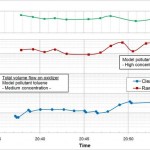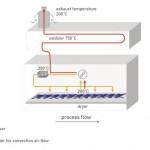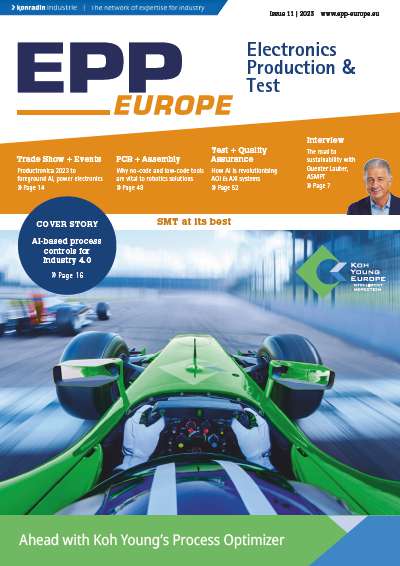The article describes the use of thermal oxidation for reducing emissions from solar dryers and firing systems in the metallisation of crystalline solar cells. With an oxidiser, emissions remain well below the statutory limitations for emissions of pollutants (e.g. TA-Luft, Germany’s Clean Air Act). The collection efficiency reaches 99.5 %, making a significant contribution to lower maintenance costs for solar dryers and firing systems.
Dr. Hans Bell & Manuel Schwarzenbolz, Rehm Thermal Systems, Blaubeuren-Seissen (Germany)
The composition of pastes for the metallisation of solar cells can be highly varied. This does not concern the actual metal content (silver or aluminium powder) but the other additives that are key to the printing properties of the paste and the baking and sintering characteristics. The proportion of these substances can be up to about 25 % by weight, of which the largest share is the organic medium in which the solids (metal powders, metal oxides, inorganic binders such as glass frit) are dispersed.
Paste handling
Typically, after being printed onto the solar cell the paste is dried at temperatures from 200 to 350° C and, in a subsequent firing process, baked into the solar cell at temperatures of 800 to 1000° C. During drying and firing of the pastes, fumes and smoke are generated. These must be safely extracted from the process chamber to avoid contamination of the system as far as possible. The fumes/smoke arise from the volatile components of the organic medium, which can consist of various organic liquids that may also contain thickeners and stabilisers. Examples of organic liquids are alcohols (Texanol) or alcohol esters (acetic acid and propionate), terpene (pine oil, terpineol), solutions of resins (polymethacrylate), solutions of ethyl cellulose in a solvent (e.g. terpineol) and the monobutyl-ether of ethylene glycol monoacetate. A preferred organic medium is ethyl cellulose in terpineol in combination with a thickening agent mixed with butyl carbitol acetate. In a study, Vogg [1] determined the weight losses using different metallization pastes.
The operator of a drying plant does not usually know the exact composition of the metallisation paste used and its volatile constituents. Therefore, a filter-/collection unit for the vapours/fumes cannot be custom-made, but must be designed for a broad range of deposition of various ingredients. At the same time, it can be expected that after passing through the filter-/collection unit the emissions will fall substantially below the limitations set by legislation, such as the Clean Air Act (see [3]).
Very often, so-called condensate separators are used in the manufacturing. On the one hand, the collection efficiency is limited, and on the other hand, the mandatory disposal of the accumulated condensates is expensive.
Clever solution
For these reasons Rehm has taken the known method of thermal oxidation for solar systems and implemented it in an innovative way. The thermal oxidation is a process that takes the volatile organic components and hydrocarbons from the metallisation paste and binds them with oxygen, essentially breaking them down into water vapour and carbon dioxide. The goal is to burn the long-chain molecules in the vapours/fumes and convert them into easily volatile substances that condense only with difficulty. These can then be easily removed from the system, which thus drastically reduces the potential for condensation within the drying system. The thermal oxidation is initiated by the heat of the exhaust gas at a temperature >750° C. At the high temperatures the molecules break down and bind to the available oxygen in the system. To achieve these high temperatures, Rehm deploys strictly electrical heating systems; the use of open flames is deliberately avoided. The risk of NOx gases forming is thus ruled out as far as possible. Measurements of ILK Dresden [2] document a collection efficiency for the pollutant toluene that reaches 99.5 % in the high temperatures in the oxidiser. With the thermal oxidation, emissions are well below the legal limits set for emissions (e.g. Germany’s Clean Air Act). Good separation behaviour was achieved not only for volatile organic hydrocarbons (VOCs), but also for the particulate distribution. A clean gas value of particles below 0.2 microns was gravimetrically determined by ILK (the Institute of Air Handling and Refrigeration in Dresden) [2] to be about 2 mg/m³. The oxidiser also copes well with different concentrations, as other measurements by ILK document [4]. At five times the concentration of the model pollutant toluene, the collection efficiency remained > 99.5 %.
The oxidiser contributes significantly to minimising the condensation potential, thus significantly minimising the cost of maintenance for dryer systems. As no more condensate can be formed on the clean gas side, the main extraction system of the fabrication plant remains visibly cleaner. A highly positive side effect is the markedly lower odour of solar dryers with an integrated oxidiser. The horizontal integration allows a compact construction of the entire drying system, and through its lengthy gas routing it secures the necessary gas contact time, resulting in an excellent collection efficiency at high temperatures.
With the help of a fan, the hot raw contaminated gas is drawn off from the process chamber of the solar dryer and passed directly through the electrical heating unit of the oxidiser to be warmed to the high temperature of 750° C that is required. The flow is set (~ 170 m³/h actual flow) so that a sufficiently long residence time of the raw gas of >1 s at this high temperature is guaranteed. The oxidiser is optimised for energy use, resulting in an operational power draw of <18 kW.
In general, thermal oxidation systems can be used for almost all organic pollutants and are thus a very good alternative to condensate discharges. The main advantage over the condensate separation is significantly reduced maintenance costs of solar dryers and firing systems.
The main advantages of thermal oxidation are:
- Reduction in maintenance costs, no disposal of condensate
- Secure compliance with the legal requirements for emissions
- Universally applicable for various metallisation pastes
- Proven, broadband method
- Robust systems engineering
- Low energy consumption, low operating costs
- Decreased odour of solar dryers.
productronica, A4.341
Literature
[1] Florian Vogg, Ermittlung und Optimierung von Trocknungsparametern verschiedener Solarpasten, Praxissemesterbericht, Firma Rehm, Februar 2011 [[1] Determination and optimisation of drying parameters of different solar pastes, internship report, Rehm, February 2011]
[2] Ralf Heidenreich, Oxidiser Rehm, ILK-Bericht, 10.12.2010 [ILK Report, Dec.12, 2010]
[3] Bundes-Immissionsschutzgesetz, Technische Anleitung zur Reinhaltung der Luft-TA Luft, 24. Juli 2002 [Federal Pollution Control Act, Technical Instructions on Maintaining Air Quality – Clean Air Act, 24 July 2002]
[4] Ralf Heidenreich, Untersuchungen zur Schadstoffabscheidung an einem Trockner für Solar-Wafer, ILK-Bericht, 31.03.2011 [Ralf Heidenreich, Studies of pollutant deposition in a dryer for solar wafers, ILK Report, March 31, 2011]
ZUSAMMENFASSUNG
Der Artikel beschreibt die Nutzung der thermischen Oxidation für die Reduzierung der Emissionen von Solartrocknern und Firingsanlagen in Metallisierungslinien von kristallinen Solarzellen.
L’article décrit l’utilisation de l’oxydation thermique pour la réduction des émissions des séchoirs solaires et des installations de firing sur les lignes de métallisation des cellules solaires cristallines.
Share:













